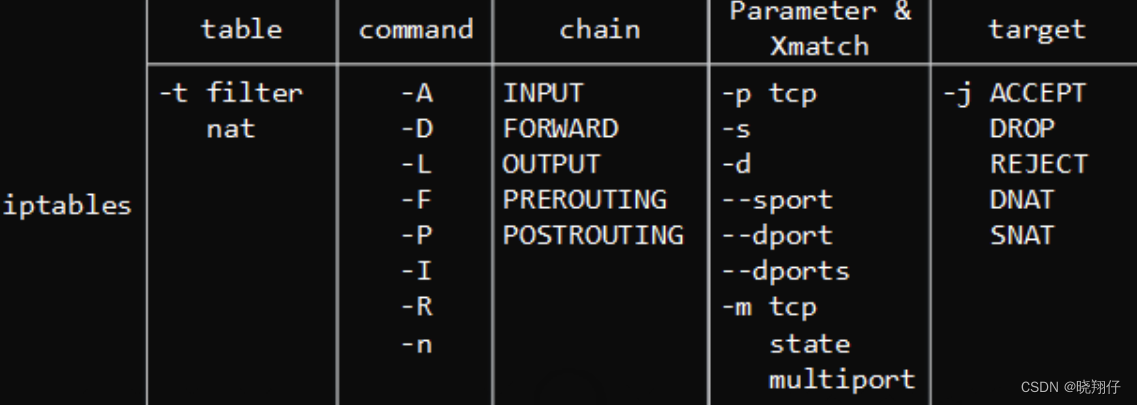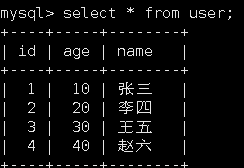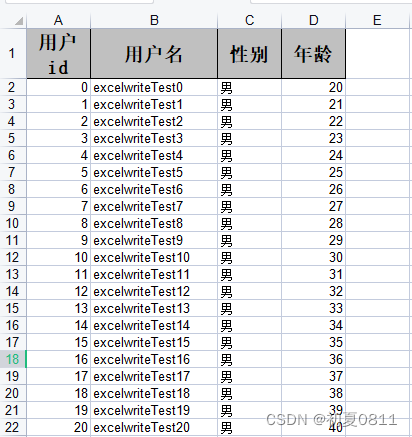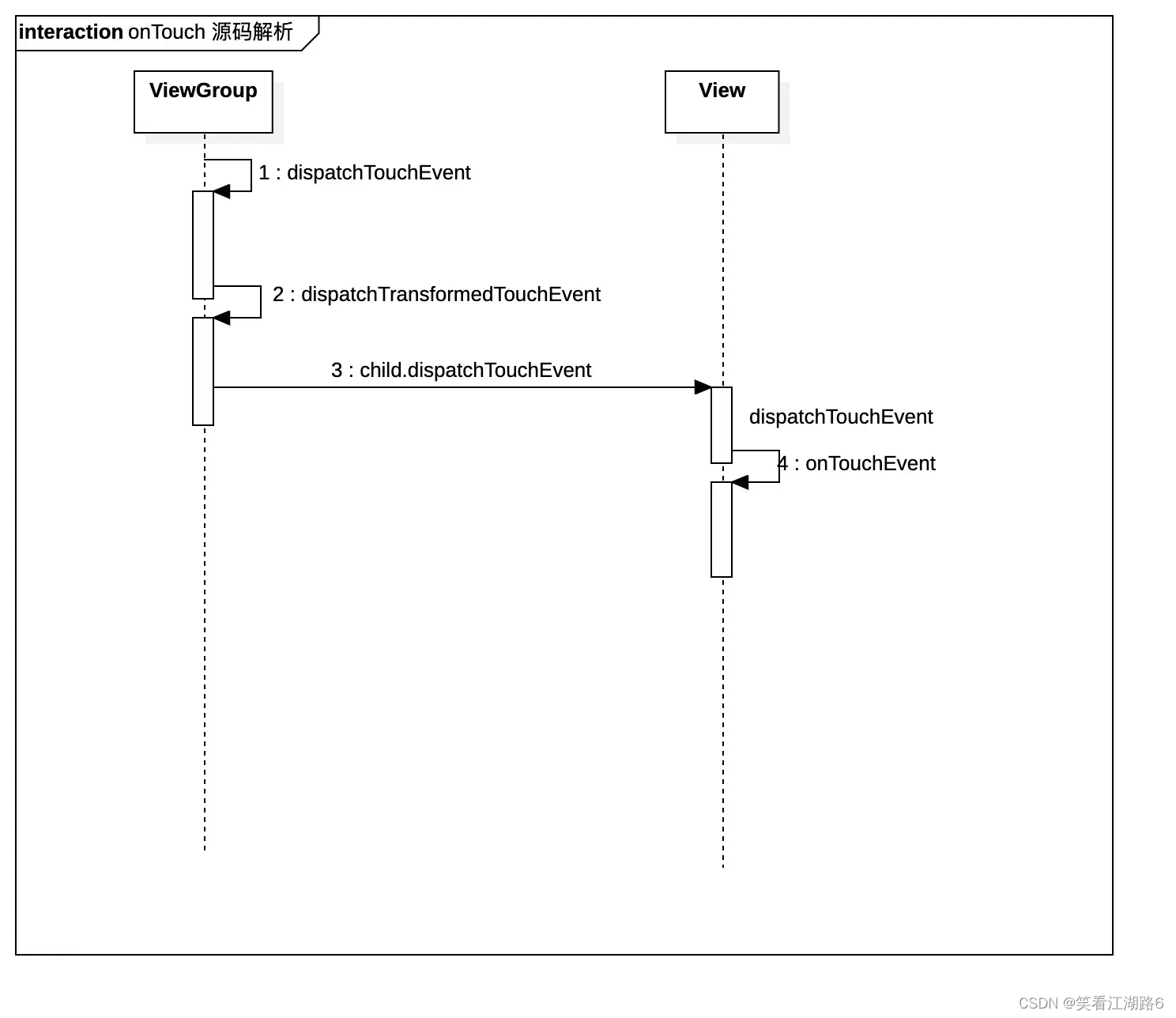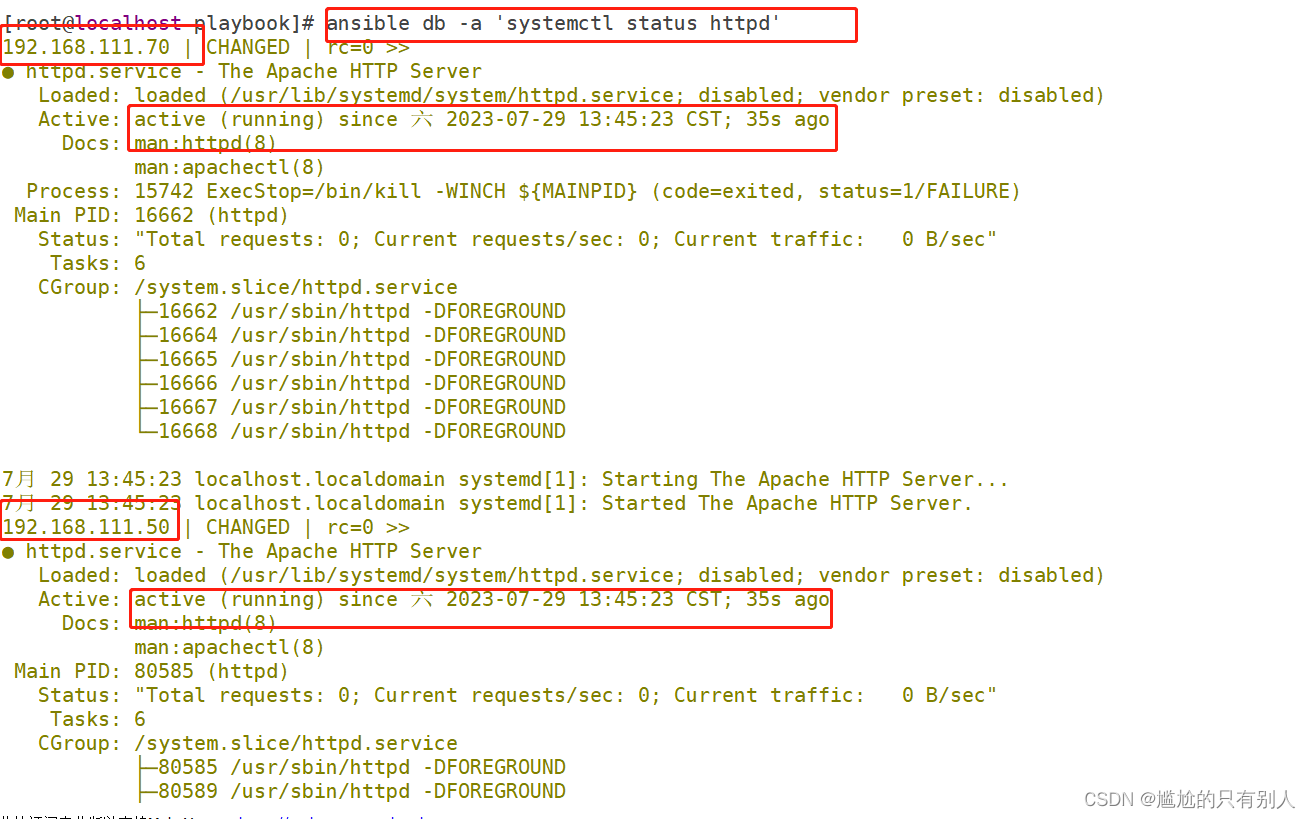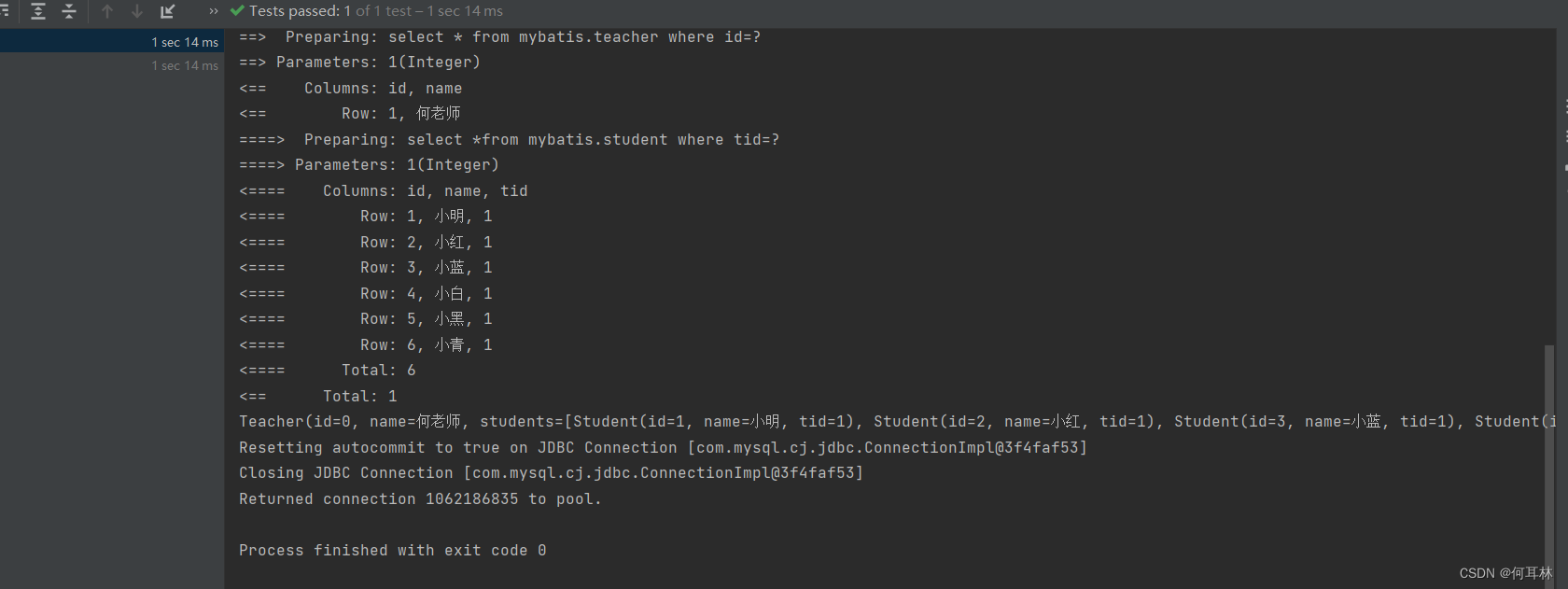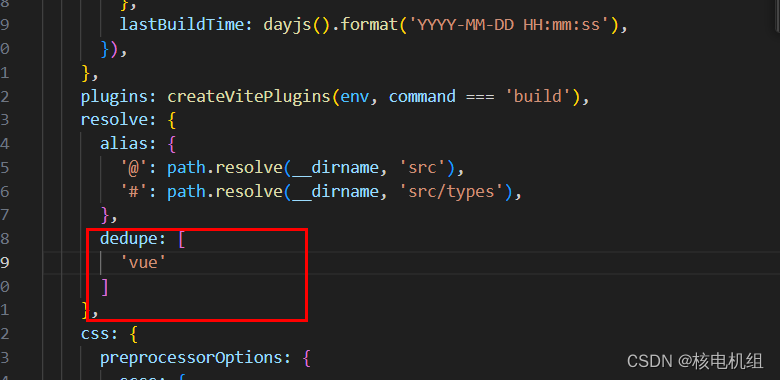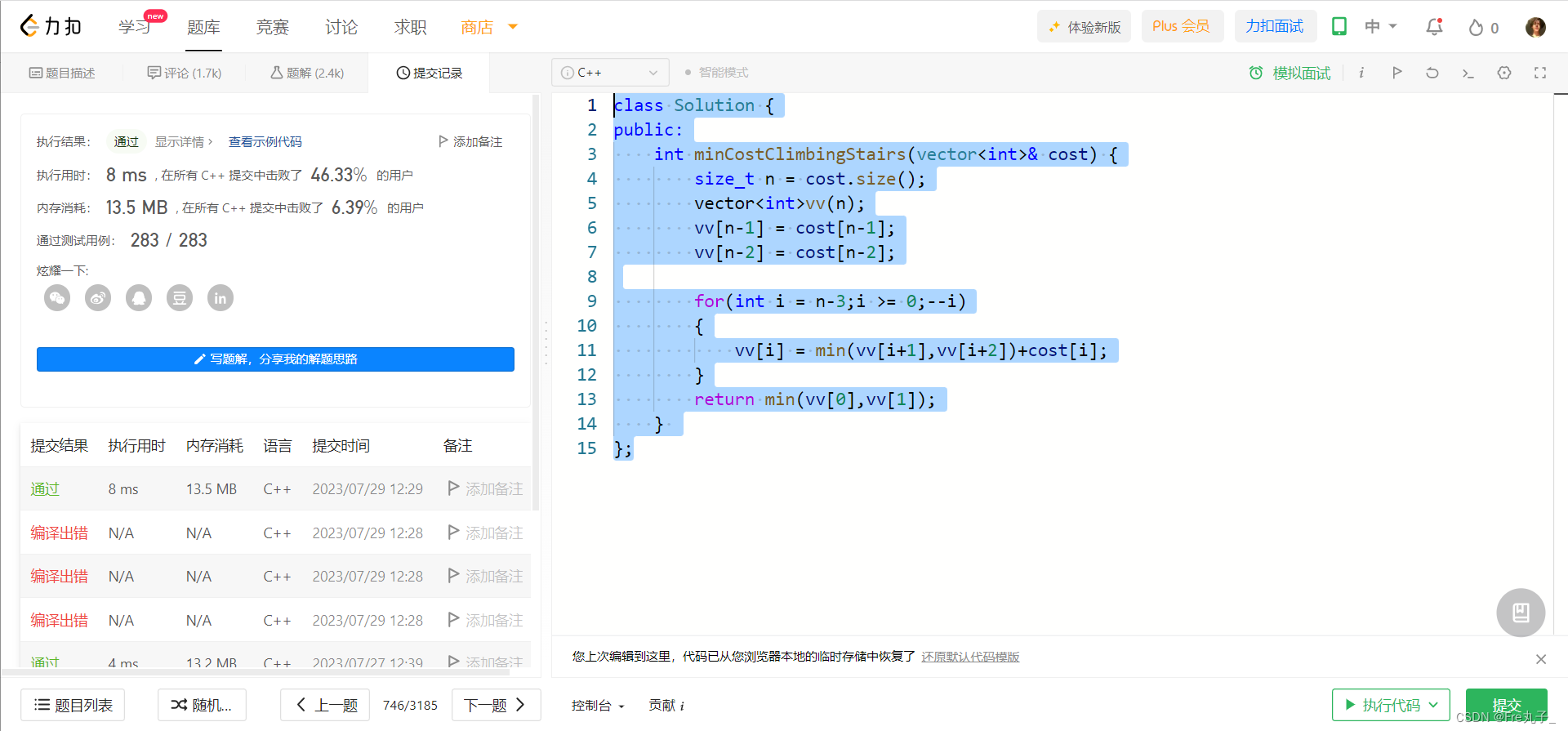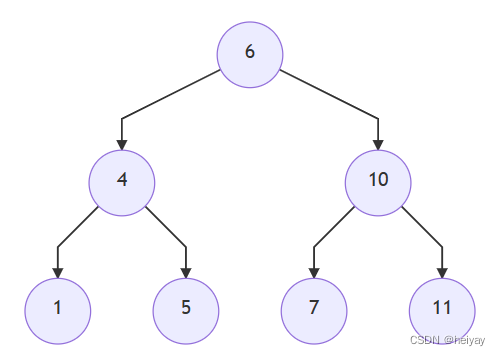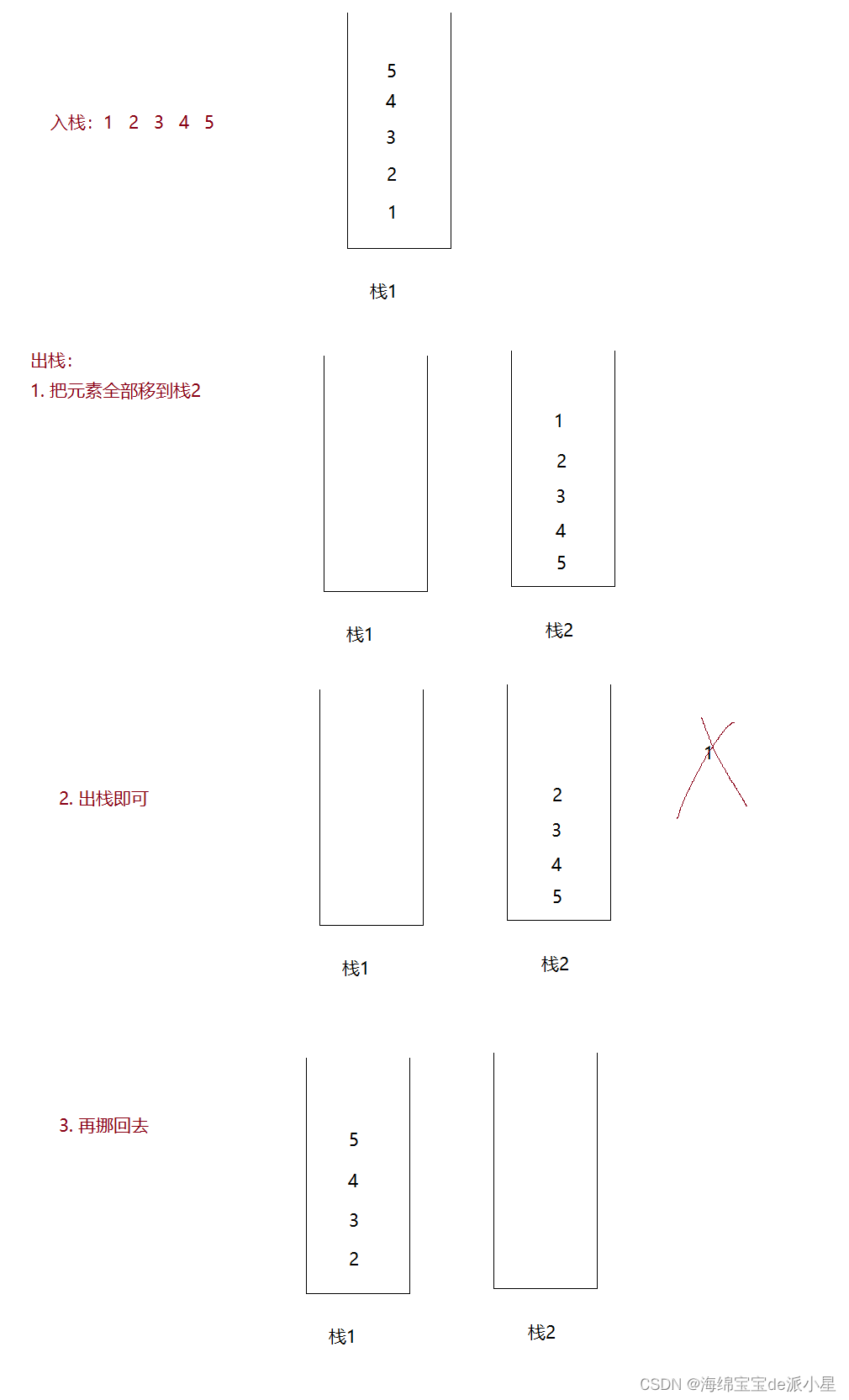【c++底层结构】AVL树&红黑树
- 1.AVL树
- 1.1 AVL树的概念
- 1.2 AVL树结点的定义
- 1.3 AVL树的插入
- 1.4 AVL树的旋转
- 1.5 AVL树的验证
- 1.6 AVL树的性能
- 2. 红黑树
- 2.1 红黑树的概念
- 2.2 红黑树的性质
- 2.3 红黑树节点的定义
- 2.4 红黑树的插入操作
- 2.5 红黑树的验证
- 2.6 红黑树与AVL树的比较
- 2.7 红黑树的应用
- 2.8 红黑树模拟实现STL中的map与set
- 3 .map和set的模拟实现
- 3.1 map的模拟实现
- 3.2 set的模拟实现
- 3.3 改造红黑树
1.AVL树
1.1 AVL树的概念
二叉搜索树虽可以缩短查找的效率,但如果数据有序或接近有序二叉搜索树将退化为单支树,,查找元素相当于在顺序表中搜索元素,效率低下。因此,两位俄罗斯的数学家G.M.Adeksib-Velskii和E.M.Landis在1962年发明了一种解决上述问题的方法:当向二叉搜索树中插入新结点后,如果能保证每个结点的左右子树高度之差的绝对值不超过1(需要对树中的结点进行调整),即可降低树的高度,从而减少平均搜索长度。
- 它的左右子树都是AVL树
- 左右子树高度之差(平衡因子)的绝对值不超过1(-1/1/0)
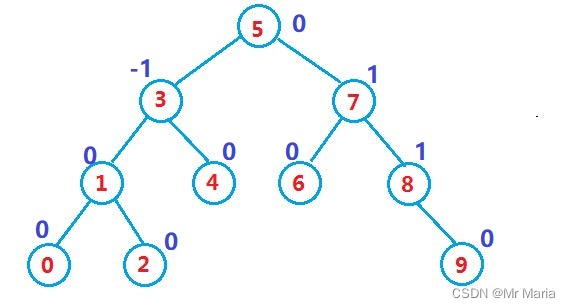 如果一颗二叉树是高度平衡的,它就是AVL、如果它有n个结点,其高度可保持在O(log2N),搜索时间复杂度O(log2N)
如果一颗二叉树是高度平衡的,它就是AVL、如果它有n个结点,其高度可保持在O(log2N),搜索时间复杂度O(log2N)
1.2 AVL树结点的定义
template<class K,class V>
class AVLTreeNode
{
AVLTreeNode<K, V>* _left; //该节点的左孩子
AVLTreeNode<K, V>* _right; //该节点的右孩子
AVLTreeNode<K, V>* _parent; //该节点的父结点
pair<K, V> _kv; //该节点的左孩子
int _bf;//balance factor //该节点的平衡因子
AVLTreeNode(const pair<K, V>& kv)
:_left(nullptr)
, _right(nullptr)
, _parent(nullptr)
, _kv(kv)
, _bf(0)
{}
};
1.3 AVL树的插入
AVL树就是在二叉搜索树的基础上引入了平衡因子,因此AVL树也可以看成是二叉搜索树。那么AVL树的插入
过程可以分为两步:
-
- 按照二叉搜索树的方式插入新节点
-
- 调整节点的平衡因子
1、更新平衡因子
1、cur == parent->_right parent->bf++
2、cur == parent->_left parent->bf–
2、如果更新完以后,平衡因子没有出现问题,(|bf|<=1)平衡结构没有受到影响,不需要处理
3、如果更新完以后,平衡出现问题,平衡结构受到影响,需要处理(旋转)
什么决定了是否要继续往上更新,parent所在的子树高度是否变化?变了继续更新,不变就不再更新。
1、parent->bf == 1 || parent->bf == -1 --> parent所在的子树变了,继续更新。(0->1 ||0->-1)
2、parent->bf==2||parent->bf == -2 -->parent所在的子树不平衡。需要处理这棵子树(旋转处理)。
3、parent->bf == 0 parent所在的子树高度不变,不用继续往上更新,插入结束。(-1->0,1->0,parent子树高度不变)
1.4 AVL树的旋转
旋转的原则:保持搜索树的性质
旋转的目的:左右均衡,降低整棵树的高度
如果在一棵原本是平衡的AVL树中插入一个新节点,可能造成不平衡,此时必须调整树的结构,使之平衡
化。根据节点插入位置的不同,AVL树的旋转分为四种:
首先我们来分析两种简单的旋转(单旋)
我们可以将需要单旋的情况抽象为下图所示的抽象图
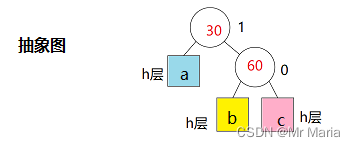
简单分析当h=1;h=2;h=3
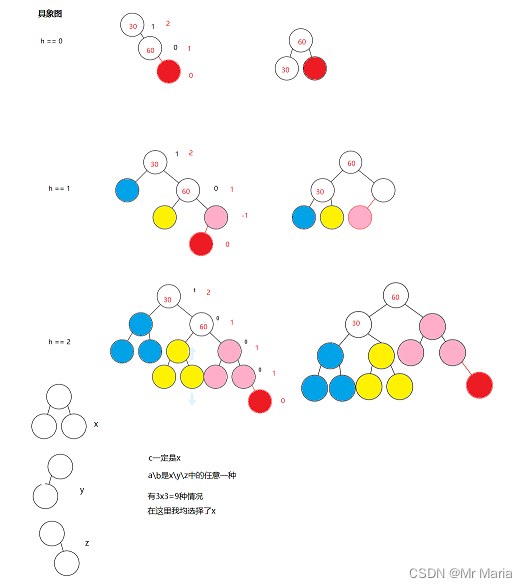
- 新节点插入较高右子树的右侧—右右:左单旋

void RotateL(Node* parent)
{
Node* subR = parent->_right;
Node* subRL = subR->_left;
//链接parent和subRL ,并更新三叉链
parent->_right = subRL;
if(subRL!=nullptr)
subRL->_parent = parent;
Node* ppnode = parent->_parent;
//链接subR和parent,并更新三叉链
subR->_left = parent;
parent->_parent = subR;
//parent为根节点
if (ppnode == nullptr)
{
_root = subR;
_root->_parent = nullptr;
}
//parent不为根节点
else
{
//与ppnode链接
if (ppnode->_left == parent)
{
ppnode->_left = subR
}
else
{
ppnode->_right = subR;;
}
subR->_parent = ppnode;
}
//更新平衡因子
parent->_bf = subR->_bf = 0;
}
- 新节点插入较高左子树的左侧–左左:右单旋

代码
void RotateR(Node * parent)
{
Node* subL = parent->_left;
Node* subLR = subL->_right;
Node* ppnode = parent->_parent;
subL->_right = parent;
parent->_parent = subL;
parent->_left = subLR;
if (subLR != nullptr)
subLR->_parent = parent;
if (ppnode == nullptr)
{
_root = subL;
_root->_parent = nullptr;
}
else
{
if (ppnode__left == parent)
{
ppnode->_left = subL;
}
else
{
ppnode->_right = subL;
}
subL->_parent = ppnode;
}
parent->_bf = subL->_bf = 0;
}
接下来我们继续分析双旋的情况。
抽象图如下
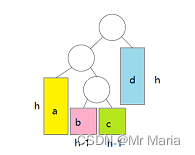
具象图如图下
吧
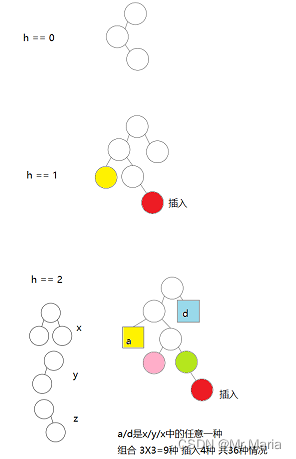
- 新节点插入较高左子树的右侧—左右:先左单旋再右单旋
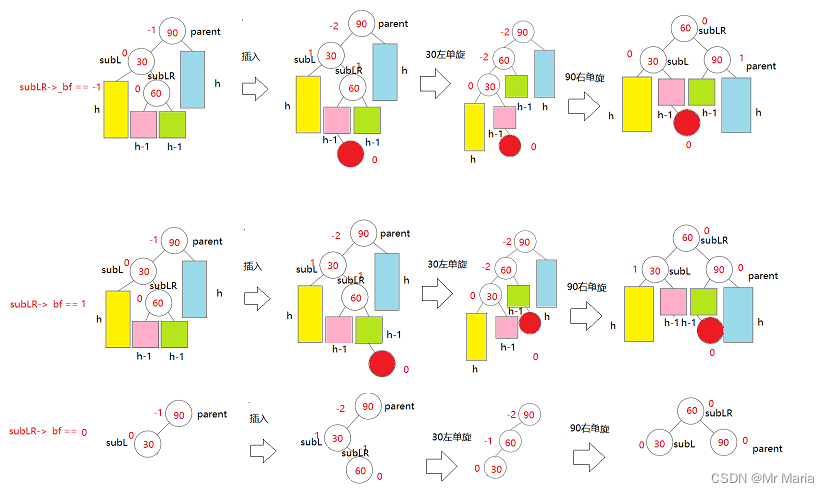
void RotateLR(Node* parent)
{
Node* subL = parent->_left;
Node* subLR = subL->_right;
int bf = subLR->_bf;
RotateL(parent->_left);
RotateR(parent);
if (bf == 1)
{
parent->_bf = 0;
subLR->_bf = 0;
subL->_bf = -1;
}
else if (bf == -1)
{
parent->_bf = 1;
subLR->_bf = 0;
subL->_bf = 0;
}
else if (bf == 0)
{
parent->_bf = 0;
subLR->_bf = 0;
subL->_bf = 0;
}
else
{
assert(false);
}
}
- 新节点插入较高右子树的左侧—右左:先右单旋再左单旋

RotateRL(Node* parent)
{
Node* subR = parent->_right;
Node* subRL = subR->_left;
int bf = subRL->_bf;
RotateR(parent->_right);
RotateL(parent);
if (bf == 1)
{
parent->_bf = -1;
subRL->_bf = 0;
subR->_bf = 0;
}
else if (bf == -1)
{
parent->_bf = 0;
subRL->_bf = 0;
subR->_bf = 1;
}
else if (bf == 0)
{
parent->_bf = 0;
subRL->_bf = 0;
subR->_bf = 0;
}
else
{
assert(false);
}
}
1.5 AVL树的验证
AVL树是在二叉搜索树的基础上加入了平衡性的限制,因此要验证AVL树,可以分两步:
- 验证其为二叉搜索树
如果中序遍历可得到一个有序的序列,就说明为二叉搜索树 - 验证其为平衡树
每个节点子树高度差的绝对值不超过1(注意节点中如果没有平衡因子)
节点的平衡因子是否计算正确
int _Height(PNode pRoot);
bool _IsBalanceTree(PNode pRoot)
{
// 空树也是AVL树
if (nullptr == pRoot) return true;
// 计算pRoot节点的平衡因子:即pRoot左右子树的高度差
int leftHeight = _Height(pRoot->_pLeft);
int rightHeight = _Height(pRoot->_pRight);
int diff = rightHeight - leftHeight;
// 如果计算出的平衡因子与pRoot的平衡因子不相等,或者
// pRoot平衡因子的绝对值超过1,则一定不是AVL树
if (diff != pRoot->_bf || (diff > 1 || diff < -1))
return false;
// pRoot的左和右如果都是AVL树,则该树一定是AVL树
return _IsBalanceTree(pRoot->_pLeft) && _IsBalanceTree(pRoot->_pRight);
}
1.6 AVL树的性能
AVL树是一棵绝对平衡的二叉搜索树,其要求每个节点的左右子树高度差的绝对值都不超过1,这样可以保证
查询时高效的时间复杂度,即 。但是如果要对AVL树做一些结构修改的操作,性能非常低下,比如:
插入时要维护其绝对平衡,旋转的次数比较多,更差的是在删除时,有可能一直要让旋转持续到根的位置。
因此:如果需要一种查询高效且有序的数据结构,而且数据的个数为静态的(即不会改变),可以考虑AVL树,
但一个结构经常修改,就不太适合。
全部代码
#pragma once
#include<assert.h>
#include<iostream>
#include<set>
#include<map>
#include<string>
using namespace std;
template<class K,class V>
struct AVLTreeNode
{
AVLTreeNode<K, V>* _left;
AVLTreeNode<K, V>* _right;
AVLTreeNode<K, V>* _parent;
pair<K, V> _kv;
int _bf;//balance factor
AVLTreeNode(const pair<K, V>& kv)
:_left(nullptr)
, _right(nullptr)
, _parent(nullptr)
, _kv(kv)
, _bf(0)
{}
};
template <class K,class V>
class AVLTree
{
typedef AVLTreeNode<K, V> Node;
public:
bool Insert(const pair<K, V>& kv)
{
if (_root == nullptr)
{
_root = new Node(kv);
return true;
}
Node* parent = nullptr;
Node* cur = _root;
while (cur)
{
if (cur->_kv.first < kv.first)
{
parent = cur;
cur = cur->_right;
}
else if (cur->_kv.first > kv.first)
{
parent = cur;
cur = cur->_left;
}
else
{
return false;
}
}
cur = new Node(kv);
if (parent->_kv.first > kv.first)
{
parent->_left = cur;
}
else
{
parent->_right = cur;
}
cur->_parent = parent;
//更新平衡因子
while (parent)
{
if (cur == parent->_right)
{
parent->_bf++;
}
else
{
parent->_bf--;
}
if (parent->_bf == 1 || parent->_bf == -1)
{
//继续更新
parent = parent->_parent;
cur = cur->_parent;
}
else if (parent->_bf == 0)
{
break;
}
else if(parent->_bf == 2 || parent->_bf == -2)
{
//旋转处理 1、让子树平衡,2、降低这棵子树的高度
if (parent->_bf == 2 && cur->_bf == 1)
{
RotateL(parent);
}
else if (parent->_bf == -2 && cur->_bf == -1)
{
RotateR(parent);
}
else if (parent->_bf == -2 && cur->_bf == 1)
{
RotateLR(parent);
}
else if (parent->_bf == 2 && cur->_bf == -1)
{
RotateRL(parent);
}
else
{
assert(false);
}
break;
}
//在插入前平衡结构已经出现问题
else
{
assert(false);
}
}
return true;
}
void InOrder()
{
_InOrder(_root);
cout << endl;
}
bool IsBalance()
{
return _IsBalance(_root);
}
int Height()
{
return _Height(_root);
}
private:
void _InOrder(Node* root)
{
if (root == nullptr)
{
return;
}
_InOrder(root->_left);
cout << root->_kv.first << " ";
_InOrder(root->_right);
}
int _Height(Node* root)
{
if (root == NULL)
return 0;
int leftH = _Height(root->_left);
int rightH = _Height(root->_right);
return leftH > rightH ? leftH + 1 : rightH + 1;
}
bool _IsBalance(Node* root)
{
if (root == NULL)
{
return true;
}
int leftH = _Height(root->_left);
int rightH = _Height(root->_right);
if (rightH - leftH != root->_bf)
{
cout << root->_kv.first << "节点平衡因子异常" << endl;
return false;
}
return abs(leftH - rightH) < 2
&& _IsBalance(root->_left)
&& _IsBalance(root->_right);
}
void RotateL(Node* parent)
{
Node* subR = parent->_right;
Node* subRL = subR->_left;
//链接parent和subRL ,并更新三叉链
parent->_right = subRL;
if(subRL!=nullptr)
subRL->_parent = parent;
Node* ppnode = parent->_parent;
//链接subR和parent,并更新三叉链
subR->_left = parent;
parent->_parent = subR;
//parent为根节点
if (ppnode == nullptr)
{
_root = subR;
_root->_parent = nullptr;
}
//parent不为根节点
else
{
//与ppnode链接
if (ppnode->_left == parent)
{
ppnode->_left = subR;
}
else
{
ppnode->_right = subR;;
}
subR->_parent = ppnode;
}
//更新平衡因子
parent->_bf = subR->_bf = 0;
}
void RotateR(Node * parent)
{
Node* subL = parent->_left;
Node* subLR = subL->_right;
Node* ppnode = parent->_parent;
subL->_right = parent;
parent->_parent = subL;
parent->_left = subLR;
if (subLR != nullptr)
subLR->_parent = parent;
if (ppnode == nullptr)
{
_root = subL;
_root->_parent = nullptr;
}
else
{
if (ppnode->_left == parent)
{
ppnode->_left = subL;
}
else
{
ppnode->_right = subL;
}
subL->_parent = ppnode;
}
parent->_bf = subL->_bf = 0;
}
void RotateLR(Node* parent)
{
Node* subL = parent->_left;
Node* subLR = subL->_right;
int bf = subLR->_bf;
RotateL(parent->_left);
RotateR(parent);
if (bf == 1)
{
parent->_bf = 0;
subLR->_bf = 0;
subL->_bf = -1;
}
else if (bf == -1)
{
parent->_bf = 1;
subLR->_bf = 0;
subL->_bf = 0;
}
else if (bf == 0)
{
parent->_bf = 0;
subLR->_bf = 0;
subL->_bf = 0;
}
else
{
assert(false);
}
}
void RotateRL(Node* parent)
{
Node* subR = parent->_right;
Node* subRL = subR->_left;
int bf = subRL->_bf;
RotateR(parent->_right);
RotateL(parent);
if (bf == 1)
{
parent->_bf = -1;
subRL->_bf = 0;
subR->_bf = 0;
}
else if (bf == -1)
{
parent->_bf = 0;
subRL->_bf = 0;
subR->_bf = 1;
}
else if (bf == 0)
{
parent->_bf = 0;
subRL->_bf = 0;
subR->_bf = 0;
}
else
{
assert(false);
}
}
private:
Node* _root = nullptr;
};
void Test_AVLTree1()
{
int a[] = { 4, 2, 6, 1, 3, 5, 15, 7, 16, 14 };
AVLTree <int, int> t1;
for (auto e : a)
{
t1.Insert(make_pair(e,e));
}
t1.InOrder();
}
void Test_AVLTree2()
{
srand(time(0));
const size_t N = 5000000;
AVLTree<int, int> t;
for (size_t i = 0; i < N; ++i)
{
size_t x = rand() + i;
t.Insert(make_pair(x, x));
//cout << t.IsBalance() << endl;
}
//t.Inorder();
cout << t.IsBalance() << endl;
cout << t.Height() << endl;
}
2. 红黑树
2.1 红黑树的概念
红黑树,是一种二叉搜索树,但在每个节点上增加一个存储位表示节点的颜色,可以是Red或Black,通过对任何一条从根到叶子的路径上各个结点着色方式的限制,红黑树确保没有一条路径必其它路径长出两倍,因而是接近平衡的。
2.2 红黑树的性质
- 每个节点不是红色就是黑色
- 根节点是黑色的
- 如果一个节点是红色的,那么他的两个孩子结点是黑色的
- 对于每个节点,从该节点到其所有后代叶节点的简单路径上,均包含相同数目的黑色结点
- 每个叶子节点都是黑色的(NIL结点)
2.3 红黑树节点的定义
// 节点的颜色
enum Color{RED, BLACK};
// 红黑树节点的定义
template<class ValueType>
struct RBTreeNode
{
RBTreeNode<K, V>* _left;
RBTreeNode<K, V>* _right;
RBTreeNode<K, V>* _parent;
pair<K, V> _kv;
Color _col;
RBTreeNode(const pair<K, V>& kv)
:_left(nullptr)
, _right(nullptr)
, _parent(nullptr)
, _kv(kv)
, _col(RED)
{}
我们在这里选择将默认的节点颜色给成红色,是因为插入新节点时,如果是黑色的话一定会违反上述红黑树性质的第四条,其次这个节点的插入会影响到每一条路径;如果是红的的话有可能会违反第三条,同时如果造成了影响,影响到的也只是局部。
2.4 红黑树的插入操作
红黑树是在二叉搜索树的基础上加上其平衡限制条件,因此红黑树的插入可分为两步:
- 按照二叉搜索树的规则插入新节点
bool Insert(const pair<K, V>& kv)
{
if (_root == nullptr)
{
_root = new Node(kv);
_root->_col = BLACK;
return true;
}
Node* parent = nullptr;
Node* cur = _root;
while (cur)
{
if (cur->_kv.first < kv.first)
{
parent = cur;
cur = cur->_right;
}
else if (cur->_kv.first > kv.first)
{
parent = cur;
cur = cur->_left;
}
else
{
return false;
}
}
cur = new Node(kv);
if (parent->_kv.first > kv.first)
{
parent->_left = cur;
}
else
{
parent->_right = cur;
}
cur->_parent = parent;
//TODO 调整红黑树结构
return true;
}
- 检测新节点插入以后,红黑树的性质是否遭到破坏
因为新节点的默认颜色是红色,因此如果其双亲结点的颜色是黑色,没有违反红黑树任何性质,则不需要调整;单当插入节点的双亲节点颜色为红色时,就违反了性质三不能有连续的红色节点,此时就需要对红黑树分情况讨论。
首先我们先对特殊情况进行一个分析、对红黑树的节点调整建立初步印象。
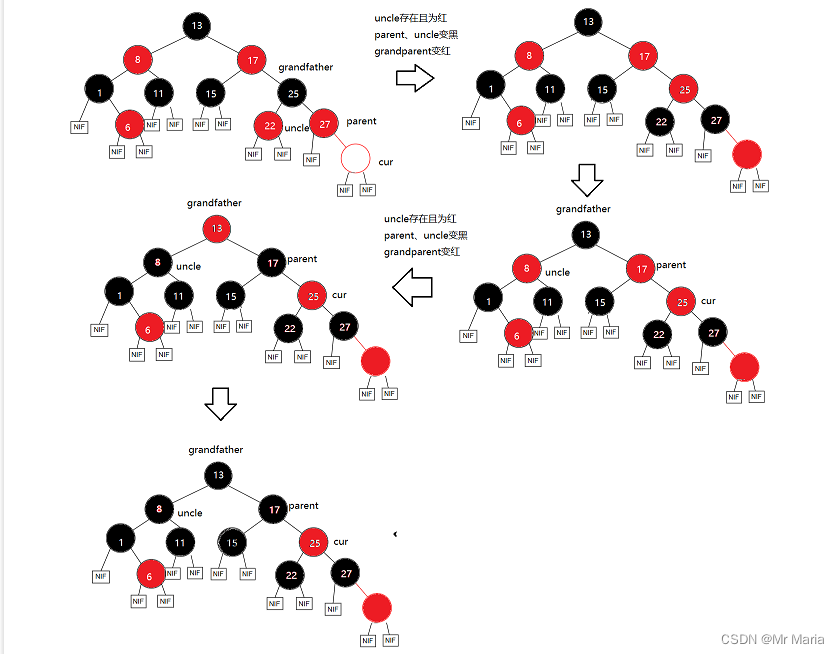
接下来我们对更一般的情况进行分析
- 情况一:cur为红 ,p为红,g为黑,u存在且为红
- 解决方法:parent 变黑 uncle变黑 grandfather变红 然后继续向上调整·
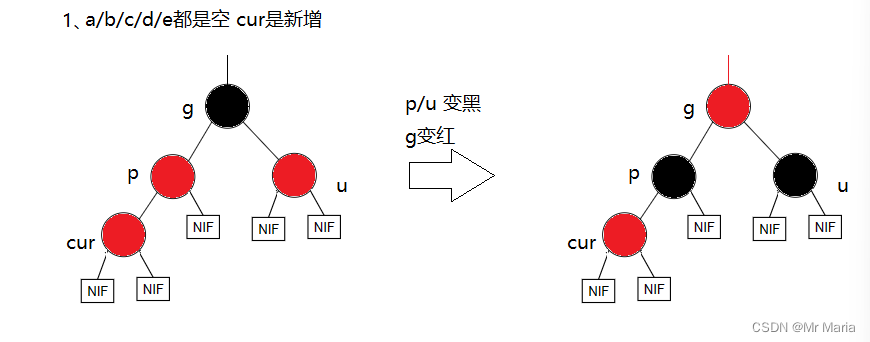

将上面的步骤翻译为代码就是
if (uncle && uncle->_col == RED)
{
parent->_col = BLACK;
uncle->_col = BLACK;
grandfather->_col = RED;
//继续向上调整
cur = grandfather;
parent = cur->_parent;
}
- 情况二: cur为红,p为红,g为黑,u不存在/u为黑(+单旋)
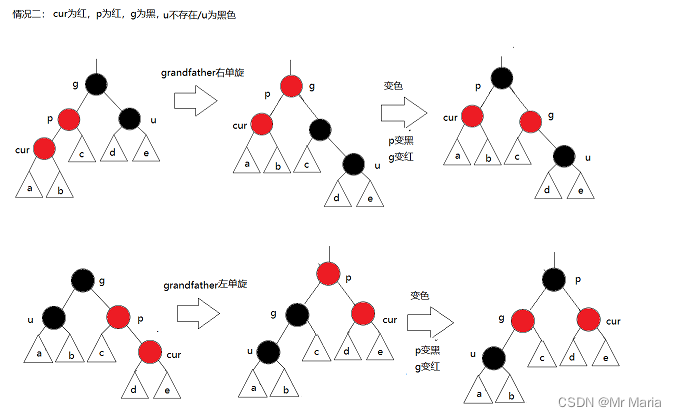
说明:u的情况有两种
1、如果u结点不存在,则cur一定是新插入结点,因为如果cur不是新插入节点,则cur和p一定有一个节点的颜色是黑色,就不满足性质4:每条路经黑色节点个数相同。
2、如果u结点存在,则其一定是黑色,那么cur结点原来的颜色一定是黑色的,现在看到其是红色的原因是因为cur的子树在调整的过程中将cur节点的颜色由黑色改为红色
p为g的左孩子,cur为p的左孩子,则进行右单旋+变色(p变黑,g变红)
p为g的右孩子,cur为p的右孩子,则进行左单旋+变色(p变黑,g变红)
- 情况三: cur为红,p为红,g为黑,u不存在/u为黑(+双旋)
p为g的左孩子,cur为p的右孩子,p做左单旋,g右单旋+变色(p变黑,g变红)
p为g的右孩子,cur为p的左孩子,p做右单旋,g左单旋+变色(p变黑,g变红)

在写代码的时候需要对up之间的关系进行分类,因为这会影响到旋转的方向
将上面三种情况翻译为代码如下:
while (parent != nullptr && parent->_col == RED)
{
Node* grandfather = parent->_parent;
if (grandfather->_left == parent)
{
Node* uncle = grandfather->_right;
//情况1:uncle存在且为红,变色处理,并继续往上处理
if (uncle && uncle->_col == RED)
{
parent->_col = BLACK;
uncle->_col = BLACK;
grandfather->_col = RED;
//继续向上调整
cur = grandfather;
parent = cur->_parent;
}
//情况2+3:uncle不存在/uncle存在且为黑,旋转+变色
else
{
// g
// p u
// c
if (cur == parent->_left)
{
RotateR(grandfather);
parent->_col = BLACK;
grandfather->_col = RED;
}
// g
// p u
// c
else
{
RotateL(parent);
RotateR(grandfather);
cur->_col = BLACK;
//parent->_col = RED;
grandfather->_col = RED;
}
break;
}
}
else//(grandfather->_right == parent)
{
// g
// u p
// c
Node* uncle = grandfather->_left;
//情况1:uncle存在且为红,变色处理,并继续往上处理
if (uncle && uncle->_col == RED)
{
parent->_col = BLACK;
uncle->_col = BLACK;
grandfather->_col = RED;
//继续向上调整
cur = grandfather;
parent = cur->_parent;
}
//情况2+3:uncle不存在/uncle存在且为黑,旋转+变色
else
{
// g
// u p
// c
if (cur == parent->_right)
{
RotateL(grandfather);
grandfather->_col = RED;
parent->_col = BLACK;
}
else
{
// g
// u p
// c
RotateR(parent);
RotateL(grandfather);
cur->_col = BLACK;
grandfather->_col = RED;
}
break;
}
}
}
_root->_col = BLACK;
2.5 红黑树的验证
红黑树的检测分为两步:
- 检测其是否满足二叉搜索树(中序遍历是否为有序序列)
- 检测其是否满足红黑树的性质(每条路径黑色节点数量相同)
bool _Check(Node* root, int blackNum, int benchmark)
{
if (root == nullptr)
{
if (benchmark != blackNum)
{
cout << "某条路径黑色节点的数量不相等" << endl;
return false;
}
return true;
}
if (root->_col == BLACK)
{
++blackNum;
}
if (root->_col == RED
&& root->_parent
&& root->_parent->_col == RED)
{
cout << "存在连续的红色节点" << endl;
return false;
}
return _Check(root->_left, blackNum, benchmark)
&& _Check(root->_right, blackNum, benchmark);
}
bool IsBalance()
{
if (_root && _root->_col == RED)
{
cout << "根节点颜色是红色" << endl;
return false;
}
int benchmark = 0;//基准点(最左路经黑色节点的数量)
Node* cur = _root;
while (cur)
{
if (cur->_col == BLACK)
++benchmark;
cur = cur->_left;
}
//连续红色结点
return _Check(_root, 0, benchmark);
}
全部代码
#pragma once
#include<assert.h>
#include<iostream>
#include<set>
#include<map>
#include<string>
using namespace std;
enum Color
{
RED,
BLACK,
};
template<class K, class V>
struct RBTreeNode
{
RBTreeNode<K, V>* _left;
RBTreeNode<K, V>* _right;
RBTreeNode<K, V>* _parent;
pair<K, V> _kv;
Color _col;
RBTreeNode(const pair<K, V>& kv)
:_left(nullptr)
, _right(nullptr)
, _parent(nullptr)
, _kv(kv)
, _col(RED)
{}
};
template<class K,class V>
class RBTree
{
typedef RBTreeNode<K, V> Node;
public:
~RBTree()
{
_Destroy(_root);
_root = nullptr;
}
Node* Find(const K& key)
{
Node* cur = _root;
while (cur)
{
if (cur->_kv.first < key)
{
cur = cur ->_right;
}
else if (cur->_kv.first > key)
{
cur = cur->_left;
}
else
{
return cur;
}
}
return nullptr;
}
bool Insert(const pair<K, V>& kv)
{
if (_root == nullptr)
{
_root = new Node(kv);
_root->_col = BLACK;
return true;
}
Node* parent = nullptr;
Node* cur = _root;
while (cur)
{
if (cur->_kv.first < kv.first)
{
parent = cur;
cur = cur->_right;
}
else if (cur->_kv.first > kv.first)
{
parent = cur;
cur = cur->_left;
}
else
{
return false;
}
}
cur = new Node(kv);
if (parent->_kv.first > kv.first)
{
parent->_left = cur;
}
else
{
parent->_right = cur;
}
cur->_parent = parent;
while (parent != nullptr && parent->_col == RED)
{
Node* grandfather = parent->_parent;
if (grandfather->_left == parent)
{
Node* uncle = grandfather->_right;
//情况1:uncle存在且为红,变色处理,并继续往上处理
if (uncle && uncle->_col == RED)
{
parent->_col = BLACK;
uncle->_col = BLACK;
grandfather->_col = RED;
//继续向上调整
cur = grandfather;
parent = cur->_parent;
}
//情况2+3:uncle不存在/uncle存在且为黑,旋转+变色
else
{
// g
// p u
// c
if (cur == parent->_left)
{
RotateR(grandfather);
parent->_col = BLACK;
grandfather->_col = RED;
}
// g
// p u
// c
else
{
RotateL(parent);
RotateR(grandfather);
cur->_col = BLACK;
//parent->_col = RED;
grandfather->_col = RED;
}
break;
}
}
else//(grandfather->_right == parent)
{
// g
// u p
// c
Node* uncle = grandfather->_left;
//情况1:uncle存在且为红,变色处理,并继续往上处理
if (uncle && uncle->_col == RED)
{
parent->_col = BLACK;
uncle->_col = BLACK;
grandfather->_col = RED;
//继续向上调整
cur = grandfather;
parent = cur->_parent;
}
//情况2+3:uncle不存在/uncle存在且为黑,旋转+变色
else
{
// g
// u p
// c
if (cur == parent->_right)
{
RotateL(grandfather);
grandfather->_col = RED;
parent->_col = BLACK;
}
else
{
// g
// u p
// c
RotateR(parent);
RotateL(grandfather);
cur->_col = BLACK;
grandfather->_col = RED;
}
break;
}
}
}
_root->_col = BLACK;
return true;
}
void InOrder()
{
_InOrder(_root);
cout << endl;
}
bool IsBalance()
{
if (_root && _root->_col == RED)
{
cout << "根节点颜色是红色" << endl;
return false;
}
int benchmark = 0;
Node* cur = _root;
while (cur)
{
if (cur->_col == BLACK)
++benchmark;
cur = cur->_left;
}
//连续红色结点
return _Check(_root, 0, benchmark);
}
int Height()
{
return _Height(_root);
}
private:
void _Destroy (Node* root)
{
if (root == nullptr)
{
return;
}
_Destroy(root->_left);
_Destroy(root->_right);
delete root;
}
int _Height(Node* root)
{
if (root == nullptr)
return 0;
int leftH = _Height(root->_left);
int rightH = _Height(root->_right);
return leftH > rightH ? leftH + 1 : rightH + 1;
}
bool _Check(Node* root, int blackNum, int benchmark)
{
if (root == nullptr)
{
if (benchmark != blackNum)
{
cout << "某条路径黑色节点的数量不相等" << endl;
return false;
}
return true;
}
if (root->_col == BLACK)
{
++blackNum;
}
if (root->_col == RED
&& root->_parent
&& root->_parent->_col == RED)
{
cout << "存在连续的红色节点" << endl;
return false;
}
return _Check(root->_left, blackNum, benchmark)
&& _Check(root->_right, blackNum, benchmark);
}
void _InOrder(Node* root)
{
if (root == nullptr)
{
return;
}
_InOrder(root->_left);
cout << root->_kv.first << " ";
_InOrder(root->_right);
}
void RotateL(Node* parent)
{
Node* subR = parent->_right;
Node* subRL = subR->_left;
//链接parent和subRL ,并更新三叉链
parent->_right = subRL;
if (subRL != nullptr)
subRL->_parent = parent;
Node* ppnode = parent->_parent;
//链接subR和parent,并更新三叉链
subR->_left = parent;
parent->_parent = subR;
//parent为根节点
if (ppnode == nullptr)
{
_root = subR;
_root->_parent = nullptr;
}
//parent不为根节点
else
{
//与ppnode链接
if (ppnode->_left == parent)
{
ppnode->_left = subR;
}
else
{
ppnode->_right = subR;
}
subR->_parent = ppnode;
}
}
void RotateR(Node* parent)
{
Node* subL = parent->_left;
Node* subLR = subL->_right;
Node* ppnode = parent->_parent;
subL->_right = parent;
parent->_parent = subL;
parent->_left = subLR;
if (subLR != nullptr)
subLR->_parent = parent;
if (ppnode == nullptr)
{
_root = subL;
_root->_parent = nullptr;
}
else
{
if (ppnode->_left == parent)
{
ppnode->_left = subL;
}
else
{
ppnode->_right = subL;
}
subL->_parent = ppnode;
}
}
private:
Node* _root;
};
void Test_RBTree1()
{
int a[] = { 4, 2, 6, 1, 3, 5, 15, 7, 16, 14 };
RBTree <int, int> t1;
for (auto e : a)
{
t1.Insert(make_pair(e, e));
}
t1.InOrder();
}
void Test_RBTree2()
{
srand(time(0));
const size_t N = 5000000;
RBTree<int, int> t;
for (size_t i = 0; i < N; ++i)
{
size_t x = rand() + i;
t.Insert(make_pair(x, x));
cout << t.IsBalance() << endl;
}
//t.Inorder();
}
2.6 红黑树与AVL树的比较
红黑树和AVL树都是搞笑的平衡二叉树,增删查改的时间复杂度都是O( log2N),红黑树不追求绝对平衡,其
只需保证最长路径不超过最短路径的2倍,相对而言,降低了插入和旋转的次数,所以在经常进行增删的结构
中性能比AVL树更优,而且红黑树实现比较简单,所以实际运用中红黑树更多。
2.7 红黑树的应用
- C++ STL库 – ma
- Java 库
- linux内核
- 其他一些库
2.8 红黑树模拟实现STL中的map与set
迭代器的好处是可以方便遍历,是数据结构的底层实现与用户透明。如果想要给红黑树增加迭代器,需要考
虑以前问题:
begin()与end()
STL明确规定,begin()与end()代表的是一段前闭后开的区间,而对红黑树进行中序遍历后,可以得到一
个有序的序列,因此:begin()可以放在红黑树中最小节点(即最左侧节点)的位置,end()放在最大节点
(最右侧节点)的下一个位置,关键是最大节点的下一个位置在哪块?能否给成nullptr呢?答案是行不通
的,因为对end()位置的迭代器进行–操作,必须要能找最后一个元素,此处就不行,因此最好的方式是
将end()放在头结点的位置
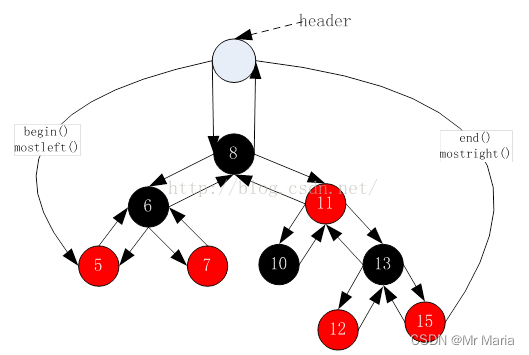
- operator++()与operator–()
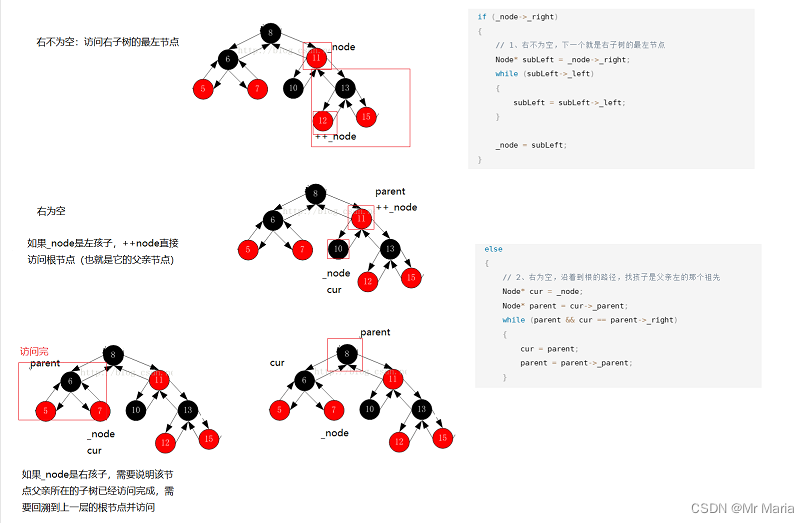
/*
template<class T, class Ref, class Ptr>
typedef __RBTreeIterator<T, Ref, Ptr> Self;
*/
Self& operator++()
{
if (_node->_right)
{
// 1、右不为空,下一个就是右子树的最左节点
Node* subLeft = _node->_right;
while (subLeft->_left)
{
subLeft = subLeft->_left;
}
_node = subLeft;
}
else
{
// 2、右为空,沿着到根的路径,找孩子是父亲左的那个祖先
Node* cur = _node;
Node* parent = cur->_parent;
while (parent && cur == parent->_right)
{
cur = parent;
parent = parent->_parent;
}
_node = parent;
}
return *this;
}
Self& operator--()
{
if (_node->_left)
{
// 1、左不为空,找左子树最右节点
Node* subRight = _node->_left;
while (subRight->_right)
{
subRight = subRight->_right;
}
_node = subRight;
}
else
{
// 2、左为空,孩子是父亲的右的那个祖先
Node* cur = _node;
Node* parent = cur->_parent;
while (parent && cur == parent->_left)
{
cur = parent;
parent = parent->_parent;
}
_node = parent;
}
return *this;
}
3 .map和set的模拟实现
首先map和set的底层结构就是红黑树,因此在map和set中分别封装一棵红黑树,然后将其接口包装下即可。为了减少代码的冗余,我们通常会引入一个新的模版参数,来区分是map还是set的调用。详情见下图:
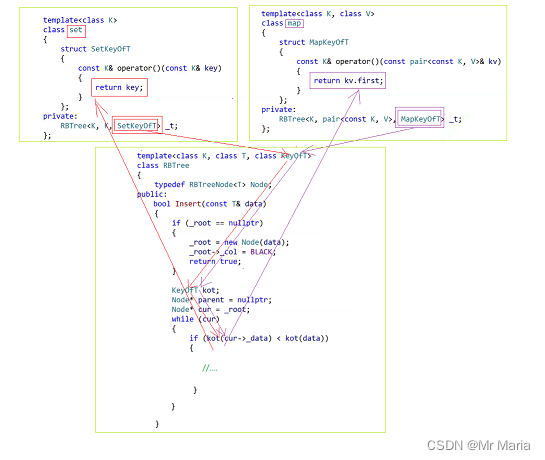
3.1 map的模拟实现
#pragma once
#include "RBTree.h"
namespace bit
{
template<class K, class V>
class map
{
struct MapKeyOfT
{
const K& operator()(const pair<const K, V>& kv)
{
return kv.first;
}
};
public:
typedef typename RBTree<K, pair<const K, V>, MapKeyOfT>::Iterator iterator;
iterator begin()
{
return _t.begin();
}
iterator end()
{
return _t.end();
}
V& operator[](const K& key)
{
pair<iterator, bool> ret = _t.Insert(make_pair(key, V()));
return ret.first->second;
}
pair<iterator, bool> insert(const pair<const K, V>& kv)
{
return _t.Insert(kv);
}
private:
RBTree<K, pair<const K, V>, MapKeyOfT> _t;
};
void test_map1()
{
map<string, string> dict;
dict.insert(make_pair("sort", "排序"));
dict.insert(make_pair("string", "ַ字符串"));
dict.insert(make_pair("count", "计数"));
dict.insert(make_pair("string", "(字符串)")); //插不进去
map<string, string>::iterator it = dict.begin();
while (it != dict.end())
{
cout << it->first << ":" << it->second << endl;
/*it->first = "1111";
it->second = "111";*/
++it;
}
cout << endl;
for (auto& kv : dict)
{
cout << kv.first << ":" << kv.second << endl;
}
cout << endl;
}
void test_map2()
{
string arr[] = { "你", "今", "天", "真", "好", "看", };
map<string, int> countMap;
for (auto& e : arr)
{
countMap[e]++;
}
for (auto& kv : countMap)
{
cout << kv.first << ":" << kv.second << endl;
}
}
}
3.2 set的模拟实现
#pragma once
#include"RBTree.h"
namespace Maria
{
template <class K>
class set
{
struct SetKeyOfT
{
const K& operator()(const K& key)
{
return key;
}
};
public:
typedef typename RBTree<K, K, SetKeyOfT>::Iterator iterator;
iterator begin()
{
return _t.begin();
}
iterator end()
{
return _t.end();
}
pair<iterator,bool> Insert(const K& key)
{
return _t.Insert(key);
}
private:
RBTree < K,K,SetKeyOfT> _t;
};
void test_set()
{
set<int> s;
s.Insert(3);
s.Insert(1);
s.Insert(2);
set<int>::iterator it = s.begin();
while (it != s.end())
{
cout << *it << " ";
++it;
}
cout << endl;
}
}
3.3 改造红黑树
#pragma once
#include<iostream>
using namespace std;
enum Colour
{
RED,
BLACK,
};
template<class T>
struct RBTreeNode
{
RBTreeNode<T>* _left;
RBTreeNode<T>* _right;
RBTreeNode<T>* _parent;
T _data;
Colour _col;
RBTreeNode(const T& data)
:_left(nullptr)
, _right(nullptr)
, _parent(nullptr)
, _data(data)
, _col(RED)
{}
};
template<class T, class Ref, class Ptr>
struct __RBTreeIterator
{
typedef RBTreeNode<T> Node;
typedef __RBTreeIterator<T, Ref, Ptr> Self;
Node* _node;
__RBTreeIterator(Node* node)
:_node(node)
{}
__RBTreeIterator(const __RBTreeIterator<T, T&, T*>& it)
:_node(it._node)
{}
Ref operator*()
{
return _node->_data;
}
Ptr operator->()
{
return &_node->_data;
}
bool operator!=(const Self& s)
{
return _node != s._node;
}
Self& operator--()
{
if (_node->_left)
{
// 1、左不为空,找左子树最右节点
Node* subRight = _node->_left;
while (subRight->_right)
{
subRight = subRight->_right;
}
_node = subRight;
}
else
{
// 2、左为空,孩子是父亲的右的那个祖先
Node* cur = _node;
Node* parent = cur->_parent;
while (parent && cur == parent->_left)
{
cur = parent;
parent = parent->_parent;
}
_node = parent;
}
return *this;
}
Self& operator++()
{
if (_node->_right)
{
// 1、右不为空,下一个就是右子树的最左节点
Node* subLeft = _node->_right;
while (subLeft->_left)
{
subLeft = subLeft->_left;
}
_node = subLeft;
}
else
{
//2、右为空、沿着到根的路径,找孩子是父亲左的那个祖先
Node* cur = _node;
Node* parent = cur->_parent;
while (parent && cur == parent->_right)
{
cur = parent;
parent = parent->_parent;
}
_node = parent;
}
return *this;
}
};
// 仿函数
template<class K, class T, class KeyOfT>
class RBTree
{
typedef RBTreeNode<T> Node;
public:
~RBTree()
{
_Destroy(_root);
_root = nullptr;
}
public:
typedef __RBTreeIterator<T, T&, T*> Iterator;
typedef __RBTreeIterator<T, const T&, const T*> const_Iterator;
Iterator begin()
{
Node* cur = _root;
while (cur && cur->_left)
{
cur = cur->_left;
}
return Iterator(cur);
}
Iterator end()
{
return Iterator(nullptr);
}
Node* Find(const K& key)
{
Node* cur = _root;
KeyOfT kot;
while (cur)
{
if (kot(cur->_data) < key)
{
cur = cur->_right;
}
else if (kot(cur->_data) > key)
{
cur = cur->_left;
}
else
{
return cur;
}
}
return nullptr;
}
pair<Iterator,bool> Insert(const T& data)
{
if (_root == nullptr)
{
_root = new Node(data);
_root->_col = BLACK;
return make_pair(Iterator(_root),true);
}
KeyOfT kot;
Node* parent = nullptr;
Node* cur = _root;
while (cur)
{
if (kot(cur->_data) < kot(data))
{
parent = cur;
cur = cur->_right;
}
else if (kot(cur->_data) > kot(data))
{
parent = cur;
cur = cur->_left;
}
else
{
return make_pair(Iterator(cur),false );
}
}
cur = new Node(data);
Node* newnode = cur;
if (kot(parent->_data) > kot(data))
{
parent->_left = cur;
}
else
{
parent->_right = cur;
}
cur->_parent = parent;
while (parent && parent->_col == RED)
{
Node* grandfather = parent->_parent;
if (grandfather->_left == parent)
{
Node* uncle = grandfather->_right;
// 情况1:u存在且为红,变色处理,并继续往上处理
if (uncle && uncle->_col == RED)
{
parent->_col = BLACK;
uncle->_col = BLACK;
grandfather->_col = RED;
// 继续往上调整
cur = grandfather;
parent = cur->_parent;
}
else // 情况2+3:u不存在/u存在且为黑,旋转+变色
{
// g
// p u
// c
if (cur == parent->_left)
{
RotateR(grandfather);
parent->_col = BLACK;
grandfather->_col = RED;
}
else
{
// g
// p u
// c
RotateL(parent);
RotateR(grandfather);
cur->_col = BLACK;
//parent->_col = RED;
grandfather->_col = RED;
}
break;
}
}
else // (grandfather->_right == parent)
{
// g
// u p
// c
Node* uncle = grandfather->_left;
// 情况1:u存在且为红,变色处理,并继续往上处理
if (uncle && uncle->_col == RED)
{
parent->_col = BLACK;
uncle->_col = BLACK;
grandfather->_col = RED;
// 继续往上调整
cur = grandfather;
parent = cur->_parent;
}
else // 情况2+3:u不存在/u存在且为黑,旋转+变色
{
// g
// u p
// c
if (cur == parent->_right)
{
RotateL(grandfather);
grandfather->_col = RED;
parent->_col = BLACK;
}
else
{
// g
// u p
// c
RotateR(parent);
RotateL(grandfather);
cur->_col = BLACK;
grandfather->_col = RED;
}
break;
}
}
}
_root->_col = BLACK;
return make_pair(Iterator(newnode), true);
}
bool IsBalance()
{
if (_root && _root->_col == RED)
{
cout << "根节点颜色是红色" << endl;
return false;
}
int benchmark = 0;
Node* cur = _root;
while (cur)
{
if (cur->_col == BLACK)
++benchmark;
cur = cur->_left;
}
// 连续红色节点
return _Check(_root, 0, benchmark);
}
int Height()
{
return _Height(_root);
}
private:
void _Destroy(Node* root)
{
if (root == nullptr)
{
return;
}
_Destroy(root->_left);
_Destroy(root->_right);
delete root;
}
int _Height(Node* root)
{
if (root == NULL)
return 0;
int leftH = _Height(root->_left);
int rightH = _Height(root->_right);
return leftH > rightH ? leftH + 1 : rightH + 1;
}
bool _Check(Node* root, int blackNum, int benchmark)
{
if (root == nullptr)
{
if (benchmark != blackNum)
{
cout << "某条路径黑色节点的数量不相等" << endl;
return false;
}
return true;
}
if (root->_col == BLACK)
{
++blackNum;
}
if (root->_col == RED
&& root->_parent
&& root->_parent->_col == RED)
{
cout << "存在连续的红色节点" << endl;
return false;
}
return _Check(root->_left, blackNum, benchmark)
&& _Check(root->_right, blackNum, benchmark);
}
void RotateL(Node* parent)
{
Node* subR = parent->_right;
Node* subRL = subR->_left;
parent->_right = subRL;
if (subRL)
subRL->_parent = parent;
Node* ppnode = parent->_parent;
subR->_left = parent;
parent->_parent = subR;
if (ppnode == nullptr)
{
_root = subR;
_root->_parent = nullptr;
}
else
{
if (ppnode->_left == parent)
{
ppnode->_left = subR;
}
else
{
ppnode->_right = subR;
}
subR->_parent = ppnode;
}
}
void RotateR(Node* parent)
{
Node* subL = parent->_left;
Node* subLR = subL->_right;
parent->_left = subLR;
if (subLR)
subLR->_parent = parent;
Node* ppnode = parent->_parent;
subL->_right = parent;
parent->_parent = subL;
if (parent == _root)
{
_root = subL;
_root->_parent = nullptr;
}
else
{
if (ppnode->_left == parent)
{
ppnode->_left = subL;
}
else
{
ppnode->_right = subL;
}
subL->_parent = ppnode;
}
}
private:
Node* _root = nullptr;
};


